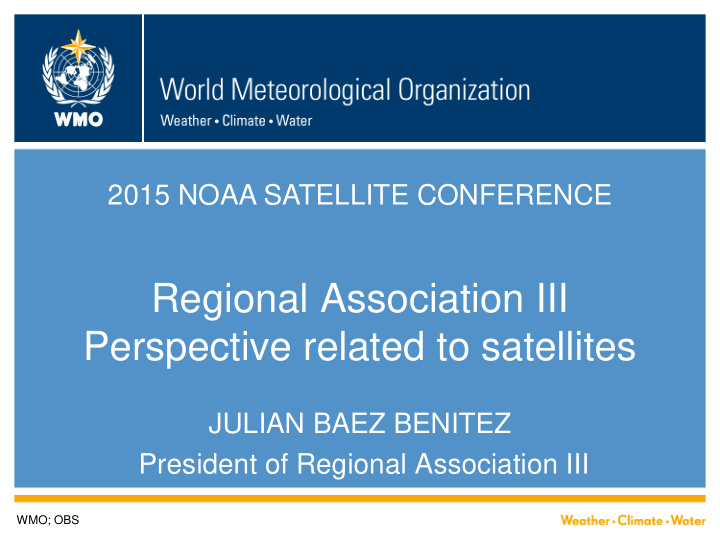



WMO 2015 NOAA SATELLITE CONFERENCE Regional Association III Perspective related to satellites JULIAN BAEZ BENITEZ President of Regional Association III WMO; OBS
Regional Association III (RA-III) of WMO It is composed by 13 countries of South America All countries are represented by a Meteorological Service and in some cases with hydrological services. B. Calpini CIMO
Mission of Meteorological Services To contribute with the security and welfare of the population and to the economic prosperity of the countries. Produce and release reliable Forecast for EWS
Establishment of Coordination Group on Satellite Data Requirements for RA-III and RA-IV The Association recalled the vital role of satellite observations from various orbits for permanent weather monitoring, and forecasting. It also recognized that in addition to operational meteorology, space-based observations cut across all component observing systems of the WIGOS, with satellite capabilities contributing to observing and monitoring climate and climate change, ocean surface, atmospheric composition, hydrological and cryosphere variables, space weather, etc.
Establishment of Coordination Group on Satellite Data Requirements for RA-III and RA-IV This group currently includes experts from seven RA III and RA IV Members (Argentina, Brazil, Canada, Colombia, Chile, Trinidad and Tobago, and the Bolivarian Republic of Venezuela) and three satellite operators (CONAE, EUMETSAT, NOAA). It has documented initial user requirements which led to improved data services via the GEONETCast-Americas and EUMETCast dissemination systems; It contributed to a better understanding of the value of satellite data for regional applications; furthermore, it has facilitated a coordinated input from satellite data users in South America, allowing NOAA to refine the specification of geostationary image coverage of the South American continent by GOES-East as indicated above. test footer 5
Current Situation of Weather Monitoring Satellite data use is greatly distributed in a variety of areas, contexts and satellites, and is most used for research and development means, education and training, weather forecasts and warnings and climate predictions and assessments. Both near-real time and historical data are important for the community. Part of the community doesn’t know the GEONETCast broadcast system.
In the current satellite generation, the Region is mostly using data from the following satellites Aqua /Terra (54.35%), GOES- E (43.48%), TRMM (39.13 %), Meteosat - 10 (34.78%) and Landsat (32.61%). Other satellites like GOES-W (26.09%), METOP (19.57%), SPOT (19.57%), SAR. Missions (19.57%), POES (17.39%), Aquarius / SAC-D (15.22%), CBERS (15.22%), DMSP (13.04%), NPP (8.70%), Jason (6.52%), Cloudsat/Calipso (4.35%), COSMIC (2.17%), Oceansat (2.17%), SMOS (2.17%), and other (26,09%).
Results of Survey in RA-III and RA-IV
Results of Survey in RA-III and RA-IV
Results of Survey in RA-III and RA-IV
Resolutions of RA-III Meeting. Asuncion, Paraguay, September 2014 The Association re-emphasized the continued need to count with higher frequency satellite imagery relating to South America, at times of severe phenomena occurrences in the Region. It also wished to obtain information, from satellite providers, about cost and technical requirements to allow regional satellite stations to receive data from the planned new generation satellites . The Association recalled the vital role of satellite observations from various orbits for permanent weather monitoring, and forecasting. It also recognized that in addition to operational meteorology, space- based observations cut across all component observing systems of the WIGOS, with satellite capabilities contributing to observing and monitoring climate and climate change, ocean surface, atmospheric composition, hydrological and cryosphere variables, space weather, etc.
Resolutions of RA-III Meeting. Asuncion, Paraguay, September 2014 In particular, the Association underlined the importance of frequent geostationary satellite observations to support nowcasting and very short-range forecasting and recalled the valuable service provided by the United States of America through the operation of a relocated GOES satellite delivering 15-minute imagery over South America from December 2006 to August 2013. Following the termination of this GOES-South America mission, the Association welcomed the measures taken by NOAA to optimize GOES-East operations, in close consultation with experts from RA III and RA IV Members, with a view to ensure at least hourly coverage of most of the Region during rapid- scan operation over North America
Resolutions of RA-III Meeting. Asuncion, Paraguay, September 2014 The Association recommended a special training effort to prepare for the new generation satellite and encouraged all Members to set up internal user preparation projects at the national level, in accordance with the CBS-15 Guidelines.
Thank you for your attention www.wmo.int
Recommend
More recommend